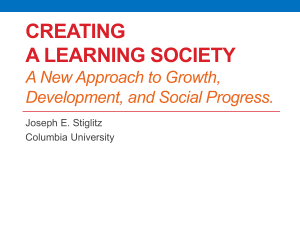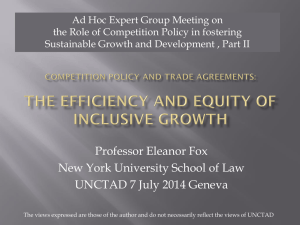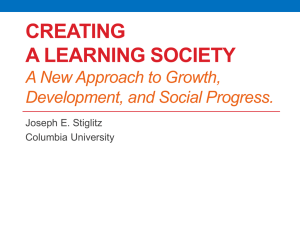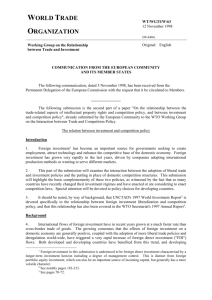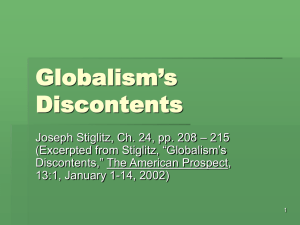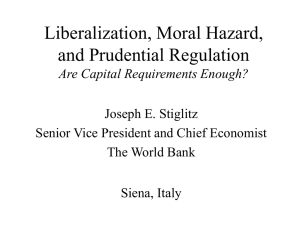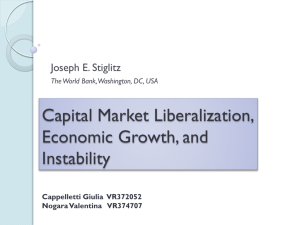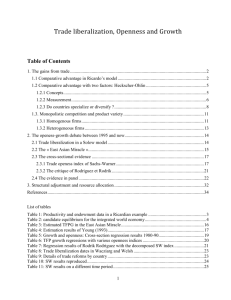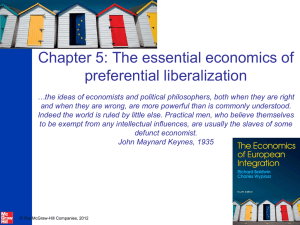Learning for a New Economy - Initiative for Policy Dialogue
advertisement
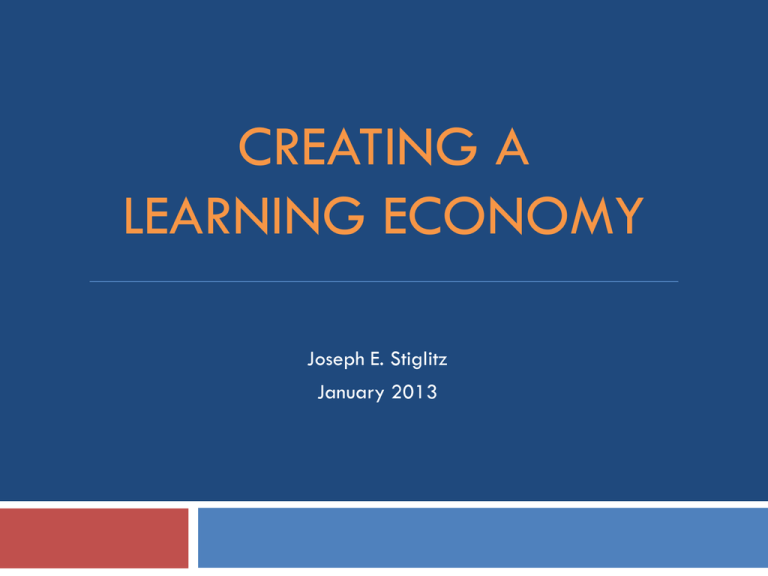
CREATING A LEARNING ECONOMY Joseph E. Stiglitz January 2013 Three themes Successful and sustained growth requires creating a learning society. − Especially in the 21st century, as we move to a knowledge economy. An open, democratic society is more conducive to the creation of a learning society. Successful and sustained democratic growth must be inclusive. Creating a Learning Society The transformation to “learning societies” that occurred around 1800 for Western economies, and more recently for those in Asia, appears to have had a far, far greater impact on human well-being than improvements in allocative efficiency or resource accumulation. Markets, on their own, are not efficient in promoting innovation. The policies that promote a transformation to a learning society are markedly different than those advocated by the WC. Indeed, from the perspective of creating a learning society, those policies may be counterproductive. Policies aimed at improving allocative efficiency and increasing resources can have large effects on learning capacities. For instance, investments in human and physical capital embody this learning. Sources of increasing standards of living Since Solow, we have recognized that the most important determinant of growth is technological change − − − Recognized earlier by Schumpeter, but Solow gave us first quantification Our focus should be on the impact of policies on technological change, learning In case of developing countries, focus on diffusion of knowledge − − From developed to developing country What separates developing from developed countries is as much a gap in knowledge as a gap in resources Since Arrow, recognized that markets by themselves do not yield efficiency in the production and dissemination of knowledge − − − Knowledge as a public good Spillovers/externalities Other imperfections (capital markets, imperfect competition) inherently associated with innovation Implies that a central question of growth and development should be: What should governments do to promote growth through learning (technological progress)? − − Markedly different perspective than standard question, which focuses on static efficiency, moving countries to “frontier” or moving out frontier through the accumulation of more resources Question is especially salient because the two policies may be in conflict − Intellectual property restricts use of knowledge (a distortion—knowledge is a public good), and can even contribute to monopoly. Willing to accept because dynamic benefits outweigh static costs − − May be negative dynamic benefits (US) Important to have a “developmentally oriented” intellectual property regime − − − With poorly designed IP regime, dynamic benefits less than the costs TRIPS (regime of WTO) is NOT developmentally oriented But important for countries to make full use of latitude given by TRIPS References This part of the talk is based on joint work with Bruce Greenwald “Helping Infant Economies Grow,” American Economic Review: AEA Papers and Proceedings, Vol. 96, No. 2, May 2006, pp. 141-146. Forthcoming book from Columbia University Press, Creating a Learning Society: A New Paradigm for Development and Social Progress (An Essay in Honor of Kenneth Arrow) J. E. Stiglitz, “Learning, Growth, and Development: A Lecture in Honor of Sir Partha Dasgupta,” publication of the World Bank’s Annual Bank Conference on Development Economics 2010: Development Challenges in a Post-Crisis World, forthcoming. Published in French as “Apprentissage, croissance et développement: conférence en l’honneur de Sir Partha Dasgupta,” in Revue D’Économie du Développment, No. 4, December, 2011, pp.19-86. Key macroeconomic issue What determines growth? Relationship between growth and globalization Orthodoxy: − Alternative view: − − Trade, foreign investment drives growth Growth (productivity increases) drive trade, investment Two-way relationship—but it is even possible that effect of trade on growth is negative Answer has important policy implications Trade, investment opportunities are universal: so if they were driving force, then would expect to see similar patterns everywhere − But some open economies have grown more than others − Some economies that “managed” trade did better than some that were more open − Some regions of country grow better than others—facing same trade opportunities But growth differs markedly, suggesting it is particular forces that are driving growth − So long as governments didn’t foreclose opportunities of taking advantage of trade Must look into structure of economy and its policies Within all countries, there are large differences between average and best practices − Suggesting large scope for “learning” Contrasting perspectives Standard theories − − Focus on comparative advantage One time gain from liberalization, opening up markets Technology-based learning theories − − − Focus on diffusion of technology from developed to less developed countries And spillovers from one sector to other Dynamic comparative advantage—comparative advantage is endogenous Infant industry argument Infant industries—economies of scale − Losses during “learning phase” serve as entry barriers, putting developing countries at disadvantage − Critiques Government can’t pick winners − Infants never grow up − Better ways of providing assistance than protection—direct and transparent subsidies − Infant industry argument (cont) − Replies to critiques − Almost every successful country has had “industrial policies” − US from 19th century (telecommunications, agriculture) − − Today mostly through Defense Department Including internet and bio-tech − With private sector playing central role in bringing innovation to market − − Successful countries learned how to manage “political economy” problems Point of industrial policies is not to pick winners, but to identify externalities and other market failures − With imperfect capital markets, can’t borrow to finance initial losses − Imperfections of capital markets are endemic (asymmetries of information) − Especially in developing countries In fact, learning by doing itself provides little basis of industrial policy − Consider a two-country, two-product Ricardian world with Cobb-Douglas utility functions, with one product with learning and the other stagnant (learning internalized in country) − Consider equilibrium in which “developed” country specializes in dynamic sector − With competition, full benefits of learning are shared with developing country through price declines Central then is understanding the structure of learning within an economy—including across sectors − Many processes, practices, and institutions entail cross-sector learning/increases in productivity − Inventory control processes − Labor management processes − Computerization − Financial services Advantages of industrial sector Large—high returns to scale Long-lived—high returns from continuity (learning to learn) Stable—high returns from completion Concentrated—high rates of diffusion Strong industrial sector is basis for: More research– − − − − More resources and incentives for research and development More internalization Greater ability to support public research and development More human capital formation, including public support for human capital accumulation The development of a robust financial sector Learning to learn and cross-border knowledge flows Implication: Rate of productivity increase related to (relative) size of industrial sector. In Presence of Learning, Markets on their own are not efficient “Market failures” are pervasive When learning is external to the firm, markets fail to take account of externalites When learning limited to the firm, there is a natural monopoly − If there were no cross-sectoral or cross-firm spillovers, rational firm would take into account all learning benefits − But distortion from monopoly power In both cases, in general, market equilibrium not efficient, industrial sector too small In fact, there are always some spill-overs Central conclusion: The Infant Economy Argument for Protection The industrial sector (broadly understood, including services) may not only exhibit a larger learning elasticity, but also more spillovers to the rural/agricultural sector It is therefore desirable to encourage the industrial sector Optimal to impose some subsidies, even if taxes are distortionary Optimal subsidies lead to expansion of those sectors that have larger societal learning benefits, taking into account both direct learning and cross sectoral spillovers. Industrial Policy in the Presence of WTO constraints Broad-based export subsidies (as in East Asia) may be a desirable way of doing so But WTO has restricted the use of such subsidies Exchange rate policy may be an effective alternative − − − Lowering exchange rate below “equilibrium” (trade balance) leads to larger industrial sector and faster learning and trade surplus Avoids the problem of “picking winners” Avoids the problems posed by WTO restrictions Even pays to have a perpetual current account surplus − − Surprising — “capital” that one never uses But learning benefit exceeds the opportunity cost of funds But even if it were not desirable to do it forever, it may be an important element of development strategy − Problem with using steady-state models Extensions Trade policy can affect factor prices, and therefore the level of investment, and therefore the level of learning − More than offsetting the social costs of distortion We have focused on “learning,” but even more important is “learning to learn.” − Industrial and trade policy can enhance an economy’s learning capacities Other implications of new theory Theory of the firm − − − − Not based on transactions costs (Coase) Knowledge moves more freely within firms than across firm boundaries Resource allocations within firm are typically not based on prices, or even contracts Trade-off between “learning” and “allocative efficiency” General lessons Another example of 2nd best economics But whenever one talks about innovation, one is in the world of 2nd best economics − − − − − Credit/revenue constraints are also likely to be particularly important Imperfect competition/increasing returns to scale Risk, with imperfect risk markets All elements of standard Schumpeterian economics Should be at the center of endogenous growth theory and growth policy Revision is part of new trade framework Old trade-and-growth orthodoxy − − − Trade liberalization leads to more trade More trade leads to more growth Growth results in everyone being better off New trade framework (i) Trade liberalization often does not lead to increased trade (ii) Trade liberalization may not lead to increased growth or increased welfare (iii) Trade-generated growth may not make everyone better off − There may be large losers i)Trade liberalization often does not lead to increased trade Experiences with EBA Share of least developed countries in global trade declining ii) Trade liberalization may not lead to increased growth and well-being Growth related to technological progress − − Even more important for developing countries—closing knowledge gap Central question is how does liberalization affect diffusion and production of knowledge − Trade liberalization may have adverse effects − Especially if a badly designed IP regime is adopted − Especially if there is capital market liberalization—which can induce high levels of volatility Trade liberalization may not lead to increased growth and well-being High adjustment costs − − − Much larger for many developing countries than for advanced industrial countries Fiscal losses Implementation costs Absence of causal relationship between trade liberalization and growth Consistent with empirical study focusing on relationship of trade liberalization (not trade) on growth − Most often cited studies flawed, problems of causality, focus on wrong question Consistent with historical experiences noted earlier − − As well as more recent experiences If Korea had stuck to its comparative advantage, it would still be a rice grower iii) Trade-generated growth may not make everyone better off Trade liberalization may lead to increased inequality − − Distributive effects are inherent (Samuelson-Stolper) Adverse effects even in developing countries Especially with asymmetric trade liberalization − Capital more liberalized than labor − Agricultural subsidies retained − − − Standard analysis only said that with trade liberalization, gainers could offset losses of losers, not that they would In fact, globalization has resulted in pressures to weaken safety nets, compounding problems General lesson Policies often based on simplistic models − − − Simplistic models consistent with simplistic ideologies And used by special interests to advance particular policy agenda Trade and capital market liberalization can make everyone worse off (Pareto inferior trade and liberalization) if there are imperfect risk markets (Newbery-Stiglitz, 1982) “Political economy” objections Ideal government intervention might improve matters − But real world interventions do not Political economy objections may be true—but conclusion based on political analysis, not economic analysis − − Political analysis often more simplistic than economic analysis Moreover, liberalization is also a political agenda − − Not “perfectly applied” Asymmetric application can have adverse welfare effects Mixed historical record Question is: are problems inherent in political processes, or can political processes be improved − Historical record suggests not inevitable − But historical record does suggest caution Growth, learning and innovation: To what end? Much of innovation in advanced industrial economies has been directed towards saving labor But in many developing countries, labor is in surplus, and unemployment is the problem − Labor saving innovations exacerbate this key social problem − It is natural resources/the environment which is “underpriced” And innovation needs to be directed at saving resources and protecting the environment − Cannot just “borrow”/adapt technology from the North − Need a new “model” of innovation − These environmental impacts are important for all countries, but especially for developing countries What matters is not GDP, but the quality of life, “wellbeing” and individual capabilities − What that entails—and how it can be increased— should and can be a subject of rational inquiry − Has been an area in which Sen has made major contributions − Subject of Sen-Fitoussi-Stiglitz International Commission on the Measurement of Economic Performance and Social Progress Social transformation and the creation of a learning society Perceptions (beliefs) affect actions (choices) and are shaped by cognitive frames The categories that shape cognition are social constructions. Because belief systems affect the equilibrium, e.g. by shaping perceptions, elites have a strong incentive to influence people’s beliefs − In contrast, in a RE equilibrium cognitive frames play no role. Those in “power” typically do not control all the determinants of the evolution of beliefs. − Cultures are always contested. The general beliefs about the world are a state variable that determine which (more specific) beliefs are acceptable. How such belief systems change—and how those (like governments) who seek to deliberately change belief systems—is thus a core part of developmental analysis (Analysis based on K. Hoff and J. E. Stiglitz, 2010, “Equilibrium Fictions: A Cognitive Approach to Societal Rigidity,” American Economic Review, 100(2), May, pp. 141-146) Democracy and the creation of a learning society Ideas concerning human rights and democracy have been among the most important in shaping what is and is not acceptable. Democratic ideals question authority. Same frame of mind which is so essential for creating a dynamic, learning economy and society. A more open society generates more ideas, a flow of “mutations,” which provides not only excitement, but the possibility of dynamic evolution, rather than stasis. Non-inclusive growth can lead to nondemocratic societies Unfortunately, even if in the long run, a more dynamic society benefits most members of society, in the short run, there can be (and normally will be) losers. − − Trickle-down economics doesn’t work WC policies were often anti-poor (worse than failure to be pro-poor). Democratic processes can be shaped, and there are incentives on the part of some to maintain existing inequities. Democratic processes can then lead to the antithesis of an open and transparent society Democratic growth must be inclusive Critique of non-inclusive growth goes beyond that it is a waste of a country’s most valuable resource— its human talent—to fail to ensure that everyone lives up to his or her abilities. The political economy of inclusiveness and openness Government needs to play an important role in any economy, correcting pervasive market failures, but especially in the “creative economy” In a society with very little inequality, the only role of the state is to provide collective goods and correct market failures When there are large inequalities, interests differ − − − Distributive battles inevitably rage To prevent redistribution, role of government is circumscribed But in circumscribing government, ability to perform positive roles is also circumscribed. Circumscribing government An “independent” central bank, in reality, a central bank accountable mainly to the financial sector Budget constraints that severely limit the scope of government activity, even when there are very high investment opportunities in the public sector. Often defended by “ideology” Adverse dynamic More inequality—more circumscribed government Leading to more inequality In the long run—more unstable, lower growth Some fear that US has now embarked on this adverse dynamic − Less equality of opportunity, more inequality, than some countries of “old Europe” Lessons of the financial crisis The financial crisis has shown how misguided policies of financial market liberalization and deregulation were − − policies that served special interests well the voices of these special interests are often heard more loudly than the voices of those that are hurt by these policies General principles of a learning society have broad implications For: Financial and capital market liberalization The design of monetary policy and institutions Intellectual property regimes Investment treaties, Taxation, and expenditures on infrastructure, education, and technology Legal frameworks for corporate governance and bankruptcy Entire economic regime Objective of this lecture A new lens through which one can examine these and other policy choices facing developing countries in the coming years: The extent to which these policies assist or impede creating a learning society Countries might like to pretend that it could avoid matters of industrial policy—following the neoliberal doctrines that these are matters to be left to the market But they cannot. The choices they makes in each of these arenas will inevitably shape the economy, politics and society, for better or for worse, for decades to come.
